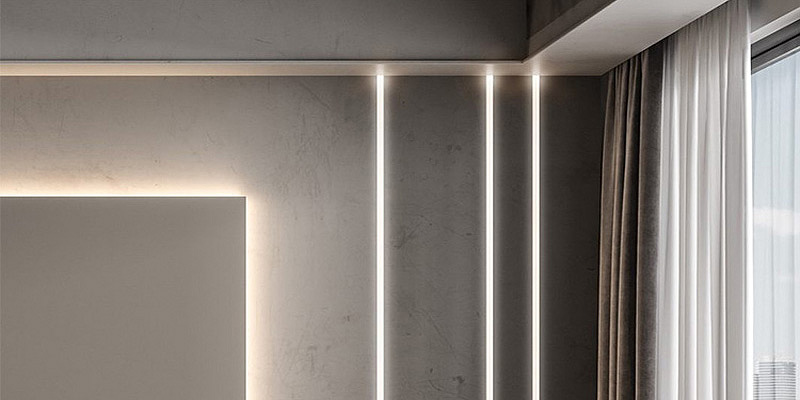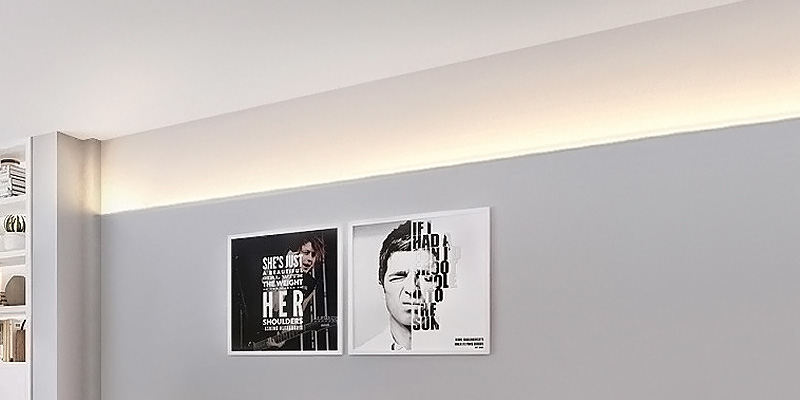For modern lighting concepts or modern styles of lighting design on home walls such as bedrooms, living rooms, staircases, hallways, dining rooms, kitchens, as well as on architectural walls like art galleries and museums, we typically consider using linear LED strip lighting or spot light fixtures as the light sources for wall illumination.
LED strip light is widely used in contemporary wall lighting design, and spot lights are used to highlight artwork and decorative objects on the wall or to localize objects or areas.
Next, we will focus on what kind of LED lighting design is suitable for walls in different locations with LED tape light and its mounting accessories – aluminum profiles.

Direct and Indirect Lighting
The choice of direct lighting or indirect lighting is also a question worth spending a little time thinking about when it comes to LED wall lighting design. Direct lighting is light that is visible to the naked eye, while indirect lighting sees light that is reflected which has a hidden light source not visible.
In home scenarios, in spaces where a cozy, relaxing atmosphere is needed, we usually tend to take the indirect LED lighting approach on the walls. For example, in the bedroom, living room, kitchen through the crown molding indirect lighting to evenly light up the entire space without affecting the visual experience at night.
In stairwells and corridors where functional lighting is needed, the choice of direct vs indirect light depends more on your personal preference. In open stairwells without handrails, the indirect staircase wall lighting can act as a handrail on the wall, as the LED strip profile is hidden in the wall, and you will not directly see the light source when you go up and down the stairs, taking into account the safety and comfort. This indirect stair wall lighting due to structural characteristics, profile embedded will form a groove, so it’s also very suitable for galleries and other art spaces.
In outdoor or indoor stairs where ambient light levels are good and the emphasis is on creating ambiance, spotlights can be chosen for walls to create light and shadow effects. For homes and residential stairways, LED strip stair lights are widely picked. With recessed led strip light profiles, even direct lighting for your stairway walls won’t cause light pollution because the intensity of the LED light strip will be pulled down by the diffuser cover of the profile, and you can also choose low-intensity LED tapes.
Home Wall Lighting Design
Ambiance creation is what home wall lighting design commonly focuses on the most. Layered waistline lighting design, which is also known as installing light strips in the middle and lower parts of the wall, can enhance the layered look of a room, such as the background wall design in the living room and the headboard lighting design in the bedroom. Half wall crown molding plays an important role in this wall lighting design, separating two wall materials or planes. On the same wall, the mid wall crown molding may have tile below and drywall above, or drywall below and above but on two levels. Contemporary middle wall crown molding adds a modern and decorative touch to a room with built-in LED strip light that makes the wall more visually appealing.
Geometric line lighting design is a lighting means that modern style homes and commercial spaces will take. The length flexibility of flexible LED strip lights gives this wall lighting design a great deal of creativity, you can create any lighting lines on the wall to express the personality and attract visitors.

Architectural Wall Lighting Design
Starting from the structure of the house building, to create the effect of washing the wall from top to bottom of the indirect ccove lighting, up and down wall washing of the linear wall sconce lighting, and to bring bright light to the overall space of the direct or indirect wall corner lighting, indirect crown molding lighting came into being.
In such wall lighting designs where LED fixtures are integrated into the architecture, LED indirect lighting is often intentionally adopted during the fixture design. Indirect wall lighting can better blend with the architectural structure, not only meeting functional lighting requirements but also enhancing the aesthetic appeal and artistic quality of the space.